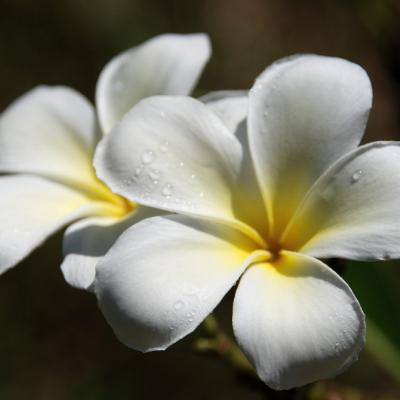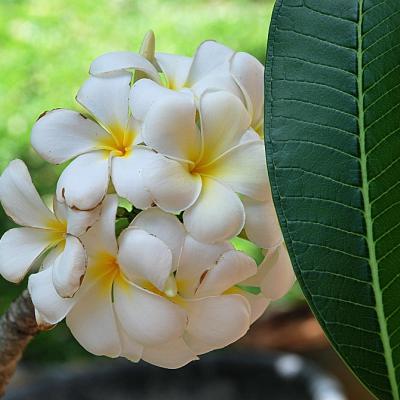Apocynaceae-Plumeria-obtusa
Classification
- Botanical Family : Apocynaceae
- Genus : Plumeria
- Epithet : obtusa
- German Family Name: Hundsgiftgewächse
- English Name: Singapore Plumeria, Singapore Graveyard Flower, Frangipani, Temple Tree
- Thai Name: ลั่นทมขาว
- Thai Phonetic: lan tom kaau
- Author: L.
Water Requirements
Plant Type
Light Requirements
Cultivation
The botanical name of Plumeria is named after the French botanist Charles Plumier from the 17th century.
The common name Frangipani was derived from an Italian family, who used first the fragrant Plumeria in perfumes.
The Plumeria obtusa in the Plumeria group is the most popular and most occurring Plumeria. Because of its most famous variety of 'Singapore White', it is called also Singapore Plumeria.
Grows as small succulent tree up to 8 m high. The fleshy branches can save water and survive for a short time under dry conditions.
Its easy to take care. Needs a well drained soil to avoid congestion wetness. Too much water can rot the roots quickly. It thrives best on calcareous soils.
The dark green, glossy leaves grow only on the branch ends. The leaves of Plumeria obtusa are leathery, inverted egg-shaped to egg-shaped- long and has characteristic veins on the underside of the leaf.
The flowers are clusters like. Each flower has five petals, which ends to a pipe. In the center have a "yellow eye". The flowers smell gentle, mostly at night to attract moths for pollination.
Plumeria obtusa is evergreen and not deciduouse like his relative Plumeria rubra.
The Plumeria tree must not be cutted, only for reasons of space. A better branch after a cut can not be expected. After the cut cause unsightly scars that are susceptible to rotting (long as they are still open).
Plumeria obtusa is also suitable as a container plant.
The milky latex is poisonous and can irritate the skin.
Propagation: By seeds or by cuttings. Sowing is quite easy, however take at least 3 to 4 years before the plumeria blooms.
Propagation by cuttings is easy too. The first flowers appear then after one year.
Der botanische Name Plumeria wurde nach dem französischen Botaniker Charles Plumier aus dem 17. Jh. benannt.
Der gebräuchliche Name Frangipani rührt von einer italienischen Familie her, die die Blütenblätter der Plumeria erstmals zu einem Parfüm verarbeiteten.
Die Plumeria obtusa ist in der Plumeria Gruppe die beliebteste und damit am häufigsten vorkommende Plumeria. Wegen ihrer bekanntesten Sorte "Singapore White" wird sie auch Singapore Plumeria genannt.
Wächst als kleinerer sukkulenter Baum bis 8 m Höhe. Die fleischigen Äste können Wasser speichern und somit kurze Trockenperioden überstehen.
Ist pflegeleicht. Braucht jedoch einen gut durchlässigen Boden, um Staunässe zu vermeiden. Zuviel Wasser lässt die Wurzeln schnell faulen. Gedeiht am besten auf kalkhaltigen Böden.
Nur an den Astenden wachsen die dunkelgrünen, glänzenden Blätter. Die Laubblätter von Plumeria obtusa sind lederig, umgekehrt eiförmig bis eiförmig-langgestreckt und zeigen eine ausgeprägte Äderung an der Blattunterseite.
Die Blüten bilden doldenähnliche Blütenbüschel. Jede Blüte selbst hat 5 Blütenblätter, die an ihren Enden zu einer Röhre zusammen wachsen und im Zentrum ein "gelbes Auge" haben. Die Blüten duften zart, am meisten jedoch nachts, um Motten zur Bestäubung anzulocken.
Plumeria obtusa ist immergrün, verliert also nicht wie seine Verwandte Plumeria rubra die Blätter.
Der Plumeria Baum muss nicht verschnitten werden, höchstens aus Platzgründen. Eine bessere Verzweigung nach einem Schnitt ist nicht zu erwarten. Auch entstehen nach einem Verschnitt unschöne Narben, die, so lange sie noch offen sind, sehr anfällig für Fäulnis sind.
Plumeria obtusa eignet sich auch als Kübelpflanze.
Der milchige Latex Saft ist giftig und kann die Haut reizen.
Vermehrung: durch Aussaat oder durch Stecklinge. Bei Aussaat, die einfach gelingt, dauert es allerdings mindestens 3 bis 4 Jahre, ehe die Plumeria blüht.
Die Vermehrung durch Stecklinge hingegen ist ebenfalls einfach. Die ersten Blüten erscheinen dann bereits nach einem Jahr.
Origin
Miscelaneous
In several Pacific islands, such as Tahiti, Fiji, Samoa, Hawaii, New Zealand, Tonga, and the Cook Islands Plumeria species are used for making leis (floral wreath). (1)
In modern Polynesian culture, it can be worn by women to indicate their relationship status - over the right ear if seeking a relationship, and over the left if taken.
Because of its amazing power of producing leafes and flowers even after being lifted from the soil, the Buddhists and the Mohammedans think the Plumeria is a symbol of immortality. This is the reason why the Plumeria is often planted near temples and cementary.
Hindus also use the flowers for their worship and to dedicated offerings to their Gods.
Ethnomedical uses
The ethnomedical information is provided for general information only, it is not intended as guidance for medicinal use.
The milky latex is used.
The latex of plumeria is iused in the tropical regions for the treatment of itching, swelling and fever. (2)
(1) Jones, Jay (April 22, 2008). "Hawaii keeps the lei-making tradition alive". Los Angeles Times.
(2) De Filipps, R. A., S. L. Maina, J. Crepin. Medicinal Plants of the Guianas. Smithsonian Institute. On-line publication. 12 June, 2006. http://www.mnh.si.edu/biodiversity/bdg/medicinal/index.html
In mehreren pazifischen Inseln wie Tahiti, Fidschi, Samoa, Hawaii, Neuseeland, Tonga, Cook-Inselnwerden die Plumeria Arten zur Herstellung der berühmten Leis (Blumenkränz) verwendet. (1)
Wegen seiner starken Kraft der Blätterbildung und Blühwilligkeit, selbst nachdem man sie umgesetzt hat, werden die Plumeria obtusa als Blume der Unsterblichkeit in der buddhistischen wie auch in der islamischen Kultur bezeichnet. Sie sind daher oft an Tempeln und Friedhöfen anzutreffen.
Hindus nutzen die Blüten in ihren Gottesdiensten als Opfergaben.
Volksmedizinische Verwendung
Die Berichte über volksmedizinische Verwendung ist nur zur allgemeinen Information und nicht als medizinischer Ratgeber zu betrachten.
Verwendet wird der weiße Milchsaft (Latex):


